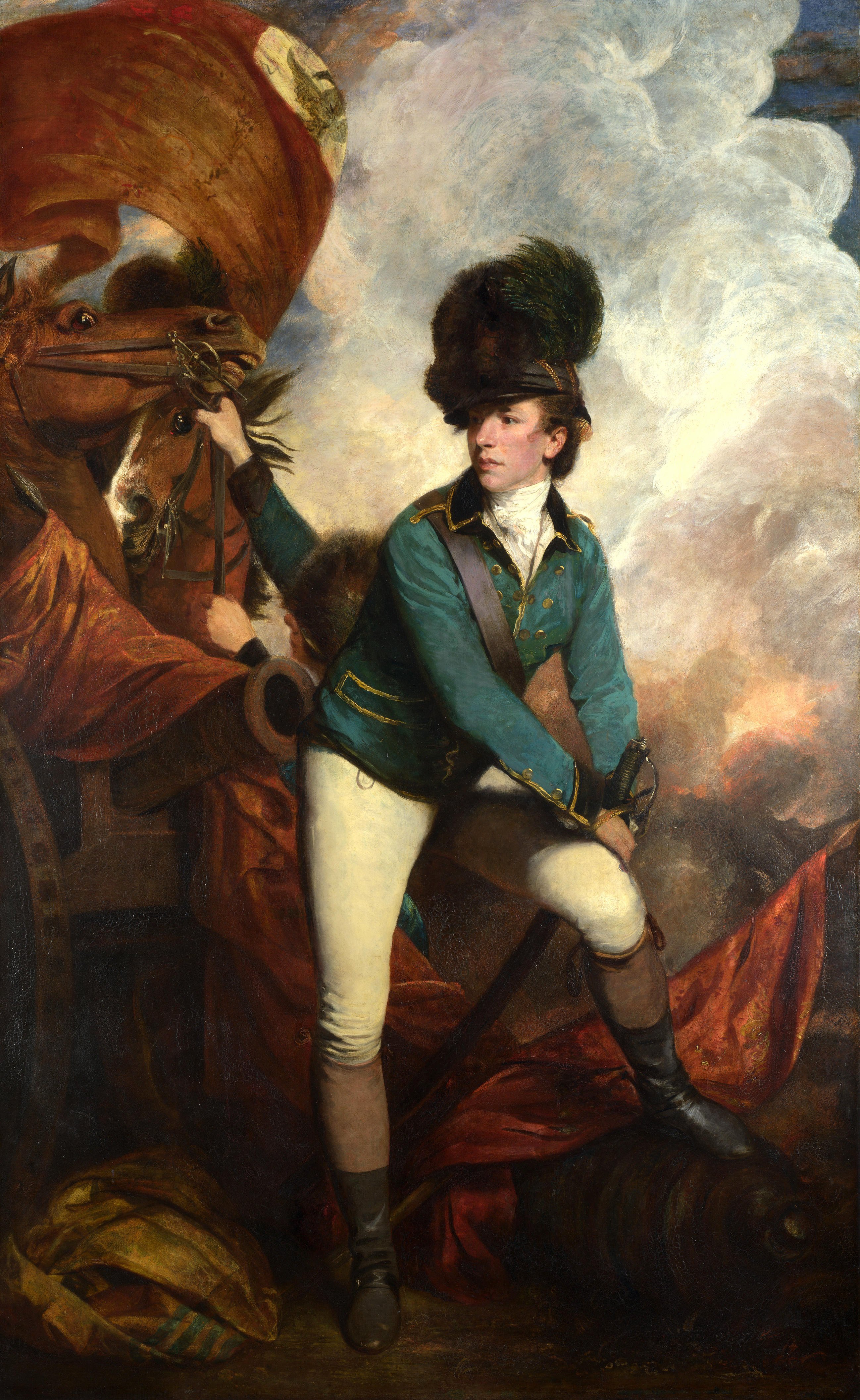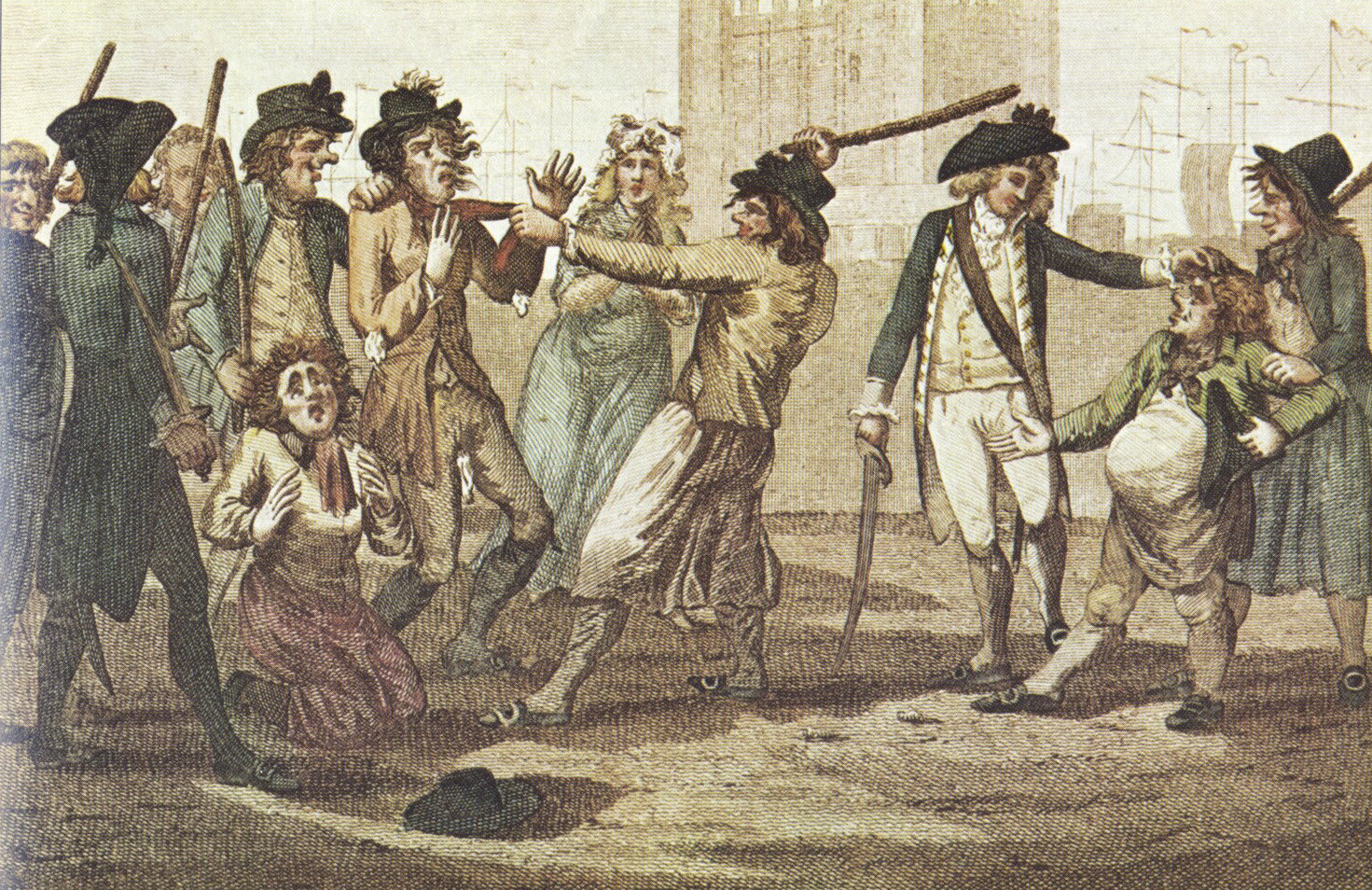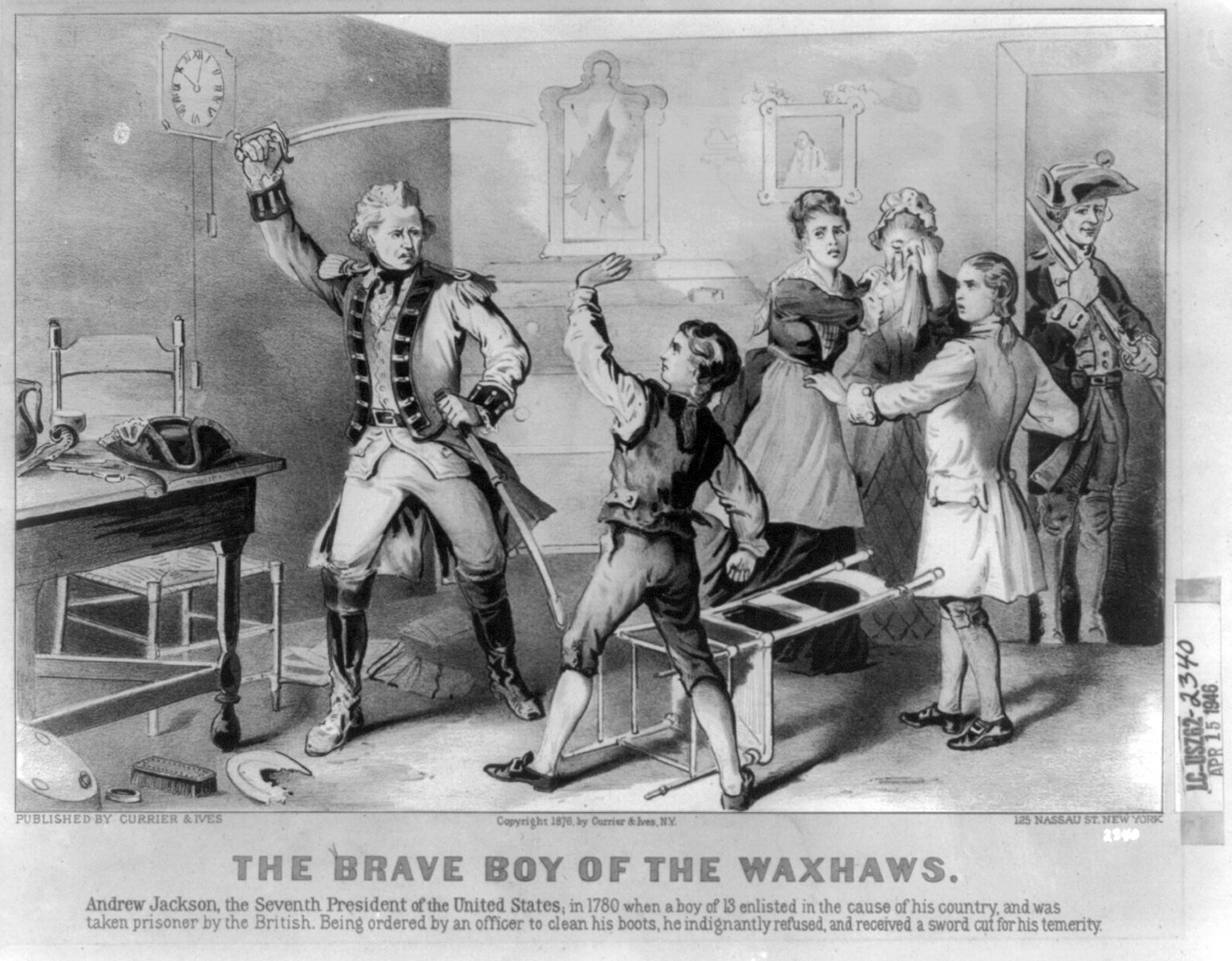|
Battle Of Waxhaws
The Waxhaw massacre, (also known as the Waxhaws, Battle of Waxhaw, and Buford's massacre) took place during the American Revolutionary War on May 29, 1780, near Lancaster, South Carolina, between a Continental Army force led by Abraham Buford and a mainly Loyalist force led by British officer Banastre Tarleton. Buford refused an initial demand to surrender, but when his men were attacked by Tarleton's cavalry, many threw down their arms to surrender. Buford apparently attempted to surrender. However, the British commanding officer Tarleton was shot at during the truce, causing his horse to fall and trap him. Loyalists and British troops were outraged at the breaking of the truce in this manner and proceeded to fall on the Americans. While Tarleton was trapped under his dead horse, the British continued killing the Continental soldiers, including soldiers who were not resisting. The British gave little quarter to the rebels. Of the 400 or so Continentals, 113 were killed with saber ... [...More Info...] [...Related Items...] OR: [Wikipedia] [Google] [Baidu] |
American Revolutionary War
The American Revolutionary War (April 19, 1775 – September 3, 1783), also known as the Revolutionary War or American War of Independence, was a major war of the American Revolution. Widely considered as the war that secured the independence of the United States, fighting began on April 19, 1775, followed by the Lee Resolution on July 2, 1776, and the Declaration of Independence on July 4, 1776. The American Patriots were supported by the Kingdom of France and, to a lesser extent, the Dutch Republic and the Spanish Empire, in a conflict taking place in North America, the Caribbean, and the Atlantic Ocean. Established by royal charter in the 17th and 18th centuries, the American colonies were largely autonomous in domestic affairs and commercially prosperous, trading with Britain and its Caribbean colonies, as well as other European powers via their Caribbean entrepôts. After British victory over the French in the Seven Years' War in 1763, tensions between the motherland and he ... [...More Info...] [...Related Items...] OR: [Wikipedia] [Google] [Baidu] |
Richard Caswell
Richard Caswell (August 3, 1729November 10, 1789) was an American politician and lawyer who served as the first and fifth governor of the state of North Carolina from 1776 to 1780 and from 1785 to 1787. He also served as a senior officer of militia in the Southern Theater of the American Revolutionary War. As a delegate to the First Continental Congress he was a signatory of the 1774 Continental Association. Early life Caswell was born on August 3, 1729, in Harford County (present-day Baltimore), Maryland; one of eleven children born to Richard and Christian () Caswell. The Caswells moved to New Bern, North Carolina, in 1745. He was appointed deputy surveyor for the province in 1750. While a member of the North Carolina House of Burgesses, a position he held for 17 years, Caswell introduced a bill establishing the "Town of Kingston" (which was later changed to Kinston as a result of the American Revolutionary War). He was a prosperous lawyer, farmer, land speculator, tanner, ... [...More Info...] [...Related Items...] OR: [Wikipedia] [Google] [Baidu] |
Rules Of War
The law of war is the component of international law that regulates the conditions for initiating war (''jus ad bellum'') and the conduct of warring parties (''jus in bello''). Laws of war define sovereignty and nationhood, states and territories, occupation, and other critical terms of law. Among other issues, modern laws of war address the declarations of war, acceptance of surrender and the treatment of prisoners of war; military necessity, along with ''distinction'' and ''proportionality''; and the prohibition of certain weapons that may cause unnecessary suffering. The ''law of war'' is considered distinct from other bodies of law—such as the domestic law of a particular belligerent to a conflict—which may provide additional legal limits to the conduct or justification of war. Early sources and history The first traces of a law of war come from the Babylonians. It is the Code of Hammurabi, king of Babylon, which, 2000 B.C., explains its laws imposing a code of con ... [...More Info...] [...Related Items...] OR: [Wikipedia] [Google] [Baidu] |
17th Regiment Of Light Dragoons (1759)
The 17th Regiment of Light Dragoons was a cavalry regiment of the British Army raised in 1759 and disbanded in 1763. It was raised in Scotland by Captain Lord Aberdour in 1759, for service in the Seven Years' War, and disbanded following the Treaty of Paris in 1763."On the institution of light cavalry", p. xxiv, in ''Historical record of the fourteenth, or the King's, regiment of Light Dragoons'', by Richard Cannon Richard Cannon (1779–1865) was a compiler of regimental records for the British Army. Career On 1 January 1802 Cannon was appointed to a clerkship at the Horse Guards, and attained the grade of first-clerk in 1803. Under a Horse Guards order .... London: Parker, Furnivall. 1847Digitised copy/ref> References Cavalry regiments of the British Army Dragoons Dragoon regiments of the British Army Light Dragoons Military units and formations established in 1759 Military units and formations disestablished in 1763 1759 establishments in Great Britain { ... [...More Info...] [...Related Items...] OR: [Wikipedia] [Google] [Baidu] |
Dragoon
Dragoons were originally a class of mounted infantry, who used horses for mobility, but dismounted to fight on foot. From the early 17th century onward, dragoons were increasingly also employed as conventional cavalry and trained for combat with swords and firearms from horseback. While their use goes back to the late 16th century, dragoon regiments were established in most European armies during the 17th and early 18th centuries; they provided greater mobility than regular infantry but were far less expensive than cavalry. The name reputedly derives from a type of firearm, called a ''dragon'', which was a handgun version of a blunderbuss, carried by dragoons of the French Army. The title has been retained in modern times by a number of armoured or ceremonial mounted regiments. Origins and name The establishment of dragoons evolved from the practice of sometimes transporting infantry by horse when speed of movement was needed. In 1552, Alexander Farnese, Duke of Parma ... [...More Info...] [...Related Items...] OR: [Wikipedia] [Google] [Baidu] |
British Army During The American War Of Independence
The British Army during the American Revolutionary War served for eight years in campaigns fought around the globe. Defeat at the Siege of Yorktown to a combined Franco-US force ultimately led to the loss of the Thirteen Colonies in eastern North America, and the concluding Treaty of Paris deprived Britain of many of the gains achieved in the Seven Years' War. However several victories elsewhere meant that much of the remaining British Empire remained intact.Holmes (2002), p. 21 In 1775 the British Army was a volunteer force. The army had suffered from lack of peacetime spending and ineffective recruitment in the decade since the Seven Years' War, circumstances which had left it in a dilapidated state at the outbreak of war in North America.Fortescue (1902), p. 172 To offset this the British government quickly hired contingents of German auxiliaries alongside the regular army units in campaigns from 1776. Limited army impressment was also introduced in England and Scotland to bols ... [...More Info...] [...Related Items...] OR: [Wikipedia] [Google] [Baidu] |
British Legion (1778)
The British Legion was a elite British provincial regiment established during the American Revolutionary War, composed of British Loyalist American infantry and dragoons. It was colloquially known as Tarleton's Raiders, the Green Devils, the Green Horse, and the Green Dragoons, after the British officer who led most of its day-to-day activities, Lieutenant Colonel Banastre Tarleton, and the green uniform coats of its officers. It was a unit the size of a regiment, consisting of artillery, cavalry, and light infantry, and able to operate independently. Regiment formed This unit was raised in New York in July 1778 by Sir Henry Clinton"Oatmeal for the Foxhounds" website, http://www.banastretarleton.org in order to merge several small Loyalist units into a single force, a "legion" that combined infantry and cavalry forces and a battery of "flying" (light and fast moving) artillery. The infantry consisted of the Caledonian Volunteers, a partially mounted and partially foot unit ... [...More Info...] [...Related Items...] OR: [Wikipedia] [Google] [Baidu] |
Charles Cornwallis, 1st Marquess Cornwallis
Charles Cornwallis, 1st Marquess Cornwallis, (31 December 1738 – 5 October 1805), styled Viscount Brome between 1753 and 1762 and known as the Earl Cornwallis between 1762 and 1792, was a British Army general and official. In the United States and the United Kingdom, he is best remembered as one of the leading British generals in the American War of Independence. His surrender in 1781 to a combined American and French force at the siege of Yorktown ended significant hostilities in North America. He later served as a civil and military governor in Ireland, where he helped bring about the Act of Union; and in India, where he helped enact the Cornwallis Code and the Permanent Settlement. Born into an aristocratic family and educated at Eton and Cambridge, Cornwallis joined the army in 1757, seeing action in the Seven Years' War. Upon his father's death in 1762 he became Earl Cornwallis and entered the House of Lords. From 1766 until 1805 he was Colonel of the 33rd Regimen ... [...More Info...] [...Related Items...] OR: [Wikipedia] [Google] [Baidu] |
Charlotte, North Carolina
Charlotte ( ) is the most populous city in the U.S. state of North Carolina. Located in the Piedmont region, it is the county seat of Mecklenburg County. The population was 874,579 at the 2020 census, making Charlotte the 16th-most populous city in the U.S., the seventh most populous city in the South, and the second most populous city in the Southeast behind Jacksonville, Florida. The city is the cultural, economic, and transportation center of the Charlotte metropolitan area, whose 2020 population of 2,660,329 ranked 22nd in the U.S. Metrolina is part of a sixteen-county market region or combined statistical area with a 2020 census-estimated population of 2,846,550. Between 2004 and 2014, Charlotte was ranked as the country's fastest-growing metro area, with 888,000 new residents. Based on U.S. Census data from 2005 to 2015, Charlotte tops the U.S. in millennial population growth. It is the third-fastest-growing major city in the United States. Residents are referr ... [...More Info...] [...Related Items...] OR: [Wikipedia] [Google] [Baidu] |
John Rutledge
John Rutledge (September 17, 1739 – June 21, 1800) was an American Founding Father, politician, and jurist who served as one of the original associate justices of the Supreme Court and the second chief justice of the United States. Additionally, he served as the first president of South Carolina and later as its first governor after the Declaration of Independence was signed. Born in Charleston, South Carolina, Rutledge established a legal career after studying at Middle Temple in the City of London. He was the elder brother of Edward Rutledge, a signatory of the Declaration of Independence. Rutledge served as a delegate to the Stamp Act Congress, which protested taxes imposed on the Thirteen Colonies by the Parliament of Great Britain. He also served as a delegate to the Continental Congress, where he signed the Continental Association, before being elected as governor of South Carolina. He served as governor during much of the American Revolutionary War. After briefly ... [...More Info...] [...Related Items...] OR: [Wikipedia] [Google] [Baidu] |
Waxhaws
The Waxhaws is a geographical region extending beyond both sides of the border between what now is North Carolina and South Carolina, United States. It encompasses the areas currently known as Lancaster, Union and Mecklenburg counties. The name is derived from that of the Indigenous people who first inhabited the landbase, the Waxhaw people. Much of the area is now the territory of the Catawba Indian Nation. Geography The region known as "The Waxhaws" is located in the Piedmont region of North Carolina and South Carolina. It lies southwest of the Uwharrie Mountains. The region encompasses an area just south of Charlotte, North Carolina, to Lancaster, South Carolina; and from Monroe, North Carolina, in the east to the Catawba River in the west. The region is generally forested and hilly, but not mountainous. One town in the region has adopted the Waxhaw name. Waxhaw, North Carolina incorporated its government in 1889. The town is only one site in the entire region, however, and i ... [...More Info...] [...Related Items...] OR: [Wikipedia] [Google] [Baidu] |






